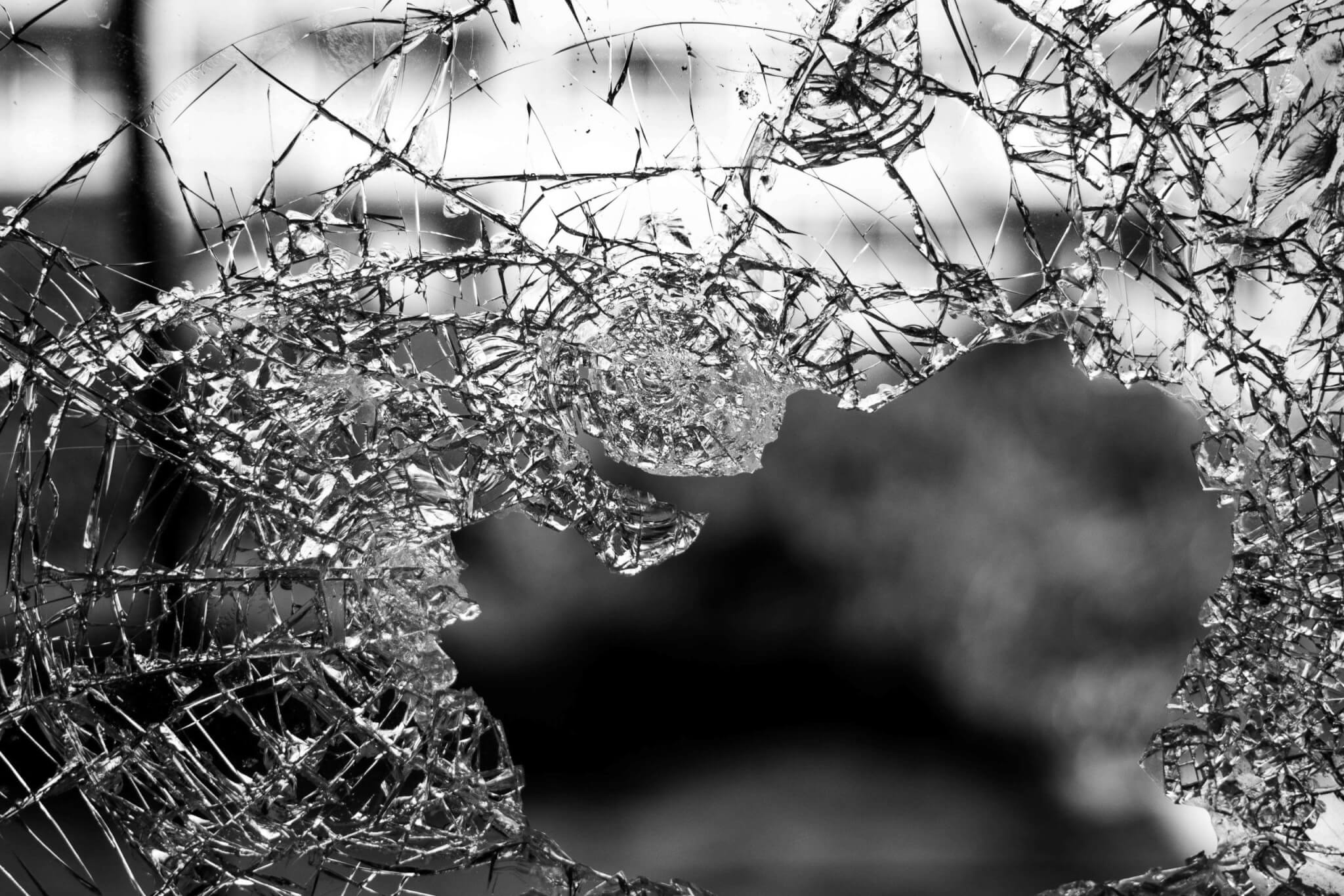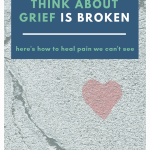The Way We Think About Grief is Broken

Short and Sweet Summary: We give cuts and broken bones time to mend. We know it takes time for them to heal and we don’t question the healing process. But, the way we think about grief is broken because we don’t afford that same grace period to grief’s healing process. Nothing can heal without time.
Grief is hard to handle, isn’t it?
We can’t quantify it, measure it or fix it.
No guidebook exists for how to get through it.
Yet we feel like grief is something we should instinctively know how to manage. Society teaches us to “get over” our grief in a reasonable time frame. Once we’re “done” grieving, we should “move on,” right?
Wrong.
So, very, very wrong.
The way we think about grief is broken.
Grief shouldn’t be rushed, hushed or crushed.
Just felt.
And for as long as necessary.
HOW TO HEAL PAIN WE CAN’T SEE
When you get a cut on your skin, it bleeds.
It’s painful.
The first thing you do is clean the cut so bacteria and gross stuff doesn’t get in and start an infection.
You know well enough to clean the cut and put a band-aid on it to shield it from debris. You’re aware, after years and years of cuts, that if you take care of the cut it will heal. After a while, the cut needs air to form a scab so you take the band-aid off.
The scab protects the skin as it continues to heal. Once the skin heals, the scab falls off. Its job is done.
We don’t question this process. You get a cut. Then you treat the cut. You wait for the cut to heal. Your body knows how to heal itself and regrow skin.
Faith in the healing process comes from years and years of treating cuts. You have faith that the bleeding will stop and a scab will form because it always does. This is how it works.
Sometimes the cut even leaves a scar. We don’t question this. At first, the scar is visible, but over time you forget it’s there because it becomes part of your skin. It’s earned a place on your skin because the scar protected you and lives there now.
The same thing applies to broken bones.
If you break a bone, the pain is unbearable. You go to the emergency room for x-rays and a cast. You know you need to get a cast and your bone will heal. You’re aware that a cast shields the bone from other fractures and reduces pain and swelling. The cast doesn’t heal the bone, it only holds the affected area in place so that the body can heal itself naturally.
We don’t question this process. You break a bone. Then you get a cast. You wait for the bone to heal. Your body knows how to heal itself and rebuild its own bones.
Faith in the healing process comes from years and years of setting and casting broken bones. You have faith that, treated properly, the bone will heal because it always does.
This is how it works.
HOW DO WE HEAL PAIN WE CAN’T SEE?
But what grief? How do you heal the unbearable pain you can’t see?
The same way you heal cuts and broken bones…with time.

But most of us lack faith in grief’s healing process. We don’t believe our shattered heart will heal because there’s no band-aid or cast big enough for this gaping wound.
X-rays can’t confirm we’re healing. Scars don’t form and provide proof.
The way we think about grief is broken because we continually question grief’s healing process because we don’t have proof we’re healing.
Nobody wants to wait it out. We look for quick fixes. We convince ourselves we’ll hurt and suffer forever because we can’t see it any other way.
NO TIMELINE EXISTS FOR GRIEF
We give cuts and broken bones time to mend, even though we can’t literally see the healing process. We don’t actually see the epidermis repair itself after a cut with healthy, new skin cells multiplying by the thousands.
Can you see through a cast to observe blood clots that change to calluses, that change to new bone cells, that help broken bones heal?
No, of course not. We don’t really see what goes on inside where the real recovery is taking place. But we KNOW the skin and bones will heal. We have faith it will heal because it always does!
When we trust the process, we believe that healing exists.
But death is unlike any other trauma. We don’t believe we can heal from the grief death brings.
When your spouse dies, the pain and suffering your heart experiences is unlike any other pain and suffering. No one can quantify how long it takes to heal from pain like this. Unlike cuts and broken bones, the trauma is personal and different for everyone.
Doctors consult charts to determine how long to cast a broken bone depending on the location and severity of the break.
Unfortunately, no chart exists to determine how long a broken heart takes to heal.
The way we think about grief is broken because we don’t trust in the grieving process. It’s too hard to believe we’ll ever overcome the trauma. It’s too intense. Too deep. Too personal.
We have little to no faith that grief healing ever happens at all.
We don’t give grief time.
GRIEF NEEDS GRACE TOO
When you get a cut you still go about your business. Even though it hurts. Even though it’s still bleeding and you’re still changing band-aids, you go about your business.
Why can’t we treat grief like that, too? Why can’t we acknowledge its presence, feel the pain, but go about our business anyway?
The way we think about grief is broken because we forget that time does eventually heal all wounds. Even though it’s a platitude we’d like to retire and never hear again, it’s true.
Little by little, hour by hour, day by day, your broken heart repairs itself.
I’m not saying time removes grief from your life completely, but unbeknownst to you, regardless of whether or not you can see it, you’re healing.
How do I know?
Because you woke up breathing today. Every day you wake up and move through the pain, you heal a little bit more. The healing isn’t pleasant. Or comfortable. I mean, grief sucks. Honestly.
But just because you’re uncomfortable or sad or mad doesn’t mean you’re not healing.
Your cuts and broken bones hurt the worst in the beginning. So does grief.
And if you don’t take care of cuts and broken bones properly, the skin might become infected or the bone might not set the right way.
Grief is like that too.
Without proper care, it can’t heal effectively.
WHAT TO DO INSTEAD
The best thing you can do is give yourself the freedom, and time, to grieve. You don’t have to like grief, but you have to give yourself the freedom to feel it.
I sure as hell don’t enjoy melting into a pile of a hot mess on the floor more than once a day. It bothers me to no end that sometimes grief shockwaves come out of nowhere and derail my best-laid plans.
But, I’ve learned how to accept grief and give myself the permission and freedom to grieve in my own space at my own pace.
I give myself time to heal like I do with cuts and broken bones.
No one can tell you how to grieve. And no one can tell you how long it’ll last. You need to define your own grieving and your own healing in your own way.
But I know that grief’s stronghold lessens when you accept it. When you agree to feel grief and allow time to do its thing.
When you have faith in the healing process.
Healing takes place when you:
- Accept your circumstances and stop comparing your own grief to others
- Learn to live with uncertainty and stop expecting to know what to do
- Allow space for grief but make taking care of yourself a priority
WIDOW WRAP UP
The way we think about grief is broken because we don’t allow our broken selves the time to heal.
We don’t give ourselves the same time and grace to heal grief like we do with cuts and broken bones.
Grief is individual, it’s personal. My way to grieve won’t be your way or your neighbor’s way. But, we must give ourselves the time and permission to grieve in our own space at our own pace.
Even though we can’t measure it or see it, we must have faith that grief healing is taking place.
When we trust the process, we believe that healing exists.
This is how it works.

